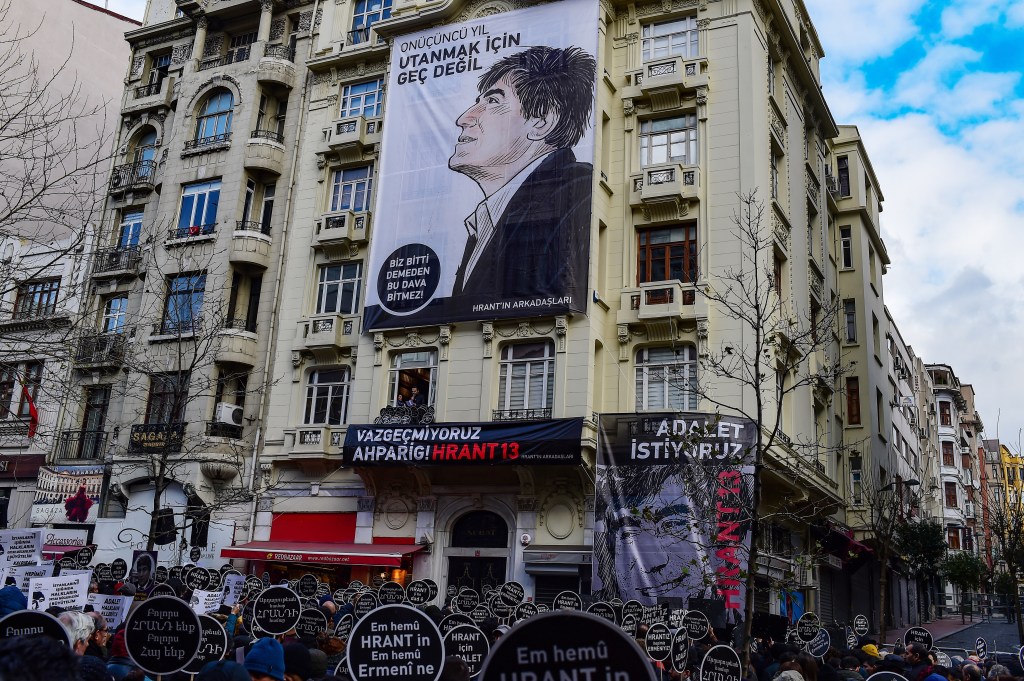After nearly 14 years and multiple court cases, the 2007 murder of Hrant Dink, a Turkish journalist of Armenian origin, remains largely unsolved even as the extended main trial appears to be set to draw to a close. Dink’s teenage killer and his immediate accomplices are behind bars, but prosecutors in the retrial, ordered by Turkey’s supreme court in 2013, have yet to pin down a broader conspiracy that Dink’s family and colleagues insist led to his death. The long-running case, in which the defense is due to begin closing arguments on December 22, shows how lack of political will to probe every lead – or worse, political interference in an investigation – can stymie the pursuit of justice for murdered journalists.
“Those who gave the kill order have yet to be found,” Yetvart Danzikyan, editor-in-chief of Agos, the Turkish-Armenian newspaper that Dink founded in 1996, told CPJ by phone in September. “That is why we do not know why [Dink] was killed.”
Prosecutors offered their closing arguments on December 14, after which the Istanbul 14th Heavy Penal Court gave lawyers for Dink’s family just two days to prepare their response. The lawyers deemed that amount of time woefully insufficient, and declined to give a statement at the December 17 hearing, according to independent news site Bianet.
That court decision followed another which lawyers for the family said impeded the search for truth. In September, judges reversed a decision to hear testimony from a senior official with the Turkish National Intelligence Agency, the MİT, according to reports. Lawyers for Dink’s family see such testimony as key to determining whether authorities covered up a plot to kill the journalist. But Turkey’s government and judiciary have all but blocked the agency’s participation in the proceedings. In 2010, then-Turkish Prime Minister Recep Tayyip Erdoğan denied permission for an investigation into the agency. And in 2011, prosecutors dropped their investigation of two agents who spoke with Dink about his reporting in 2004, a conversation Dink believed to be a veiled threat. The agents have also been prevented from serving as witnesses, as Bianet reported.
Meanwhile, changes in Turkey’s political atmosphere have continued to impact the trial, as CPJ has previously documented. When Dink was killed, powerful figures in Turkey initially blamed Ergenekon, an alleged ultranationalist conspiracy to topple the Turkish government, as behind the murder. But in recent years, blame has shifted to the Fethullah Gülen Terrorist Organization, or FETÖ. That is the Turkish government’s name for the movement of self-exiled Islamic preacher Fethullah Gülen, a former ally of Erdoğan whom the president contends was behind an attempted coup in 2016. Prosecutors in the Dink case brought charges against Gülen in 2017. Today, there are 76 defendants in the main trial, reports said.
Dink’s reporting on the Armenian plight – and specifically the atrocities against ethnic Armenians under Ottoman rule that Turkey refuses to recognize as genocide – had long made him a subject of official scrutiny. In 2004, that scrutiny reached new heights when Agos reported Sabiha Gökçen, Turkey’s first female pilot and the adopted daughter of founder of modern Turkey Mustafa Kemal Atatürk, may have been of Armenian descent. The general staff secretariat of Turkey’s military reacted with fury, declaring that “opening a national symbol like this up to discussion, for whatever reason, is a crime against national integrity and social peace.”
Shortly after, Dink was summoned to the Istanbul governor’s office where the two MİT agents allegedly warned him about his reporting, though MİT later claimed it knew of no greater plot. Next, Dink was tried for “denigrating Turkish identity” over a column in which he had actually advocated for Turkish-Armenian reconciliation. Dink was found guilty in 2005 and his appeal was denied. In his final column, republished by the Turkish foundation that bears his name, he described the growing threats against him. “In the hallways of the courthouse, fascists rained racist curses on me. They insulted me with placards and banners, and day by day the flood of threatening telephone calls, e-mails and letters was on the rise.” Nine days after the column’s original publication, on January 19, 2007, 17-year-old gunman Ogün Samast shot Dink multiple times outside of the Agos office, killing him.
In July 2007, Samast and several accomplices initially went on trial together, but Samast was later convicted of murder in a separate juvenile court. His accomplices were convicted on various charges in 2012, but a year later Turkey’s supreme court ordered a retrial (while upholding Samast’s conviction) on the basis that the original trial failed to acknowledge the murder as the result of organized crime. At the time, Dink’s supporters told CPJ that the supreme court ruling did not go far enough because it did not describe the perpetrators as part of an alleged terrorist organization, the classification of which would have allowed for a much deeper investigation. The retrial has morphed in the ensuing years, as Samast and his accomplices were spun off into a separate trial and another trial, that of law enforcement officers who allegedly knew of threats to Dink, was folded into the main one.
Danzikyan contends that the police and gendarme intelligence divisions of the northern province of Trabzon, Samast’s hometown, the Istanbul police, and even officials in Ankara, Turkey’s capital, were all aware of the risks facing Dink. “The picture we have before us is such: Hrant Dink was made a target; the state learned that an action was to be taken against Hrant Dink [and] did nothing; the [judiciary] did whatever it could to make Hrant Dink seem guilty; that is how Hrant Dink was killed.”
He acknowledged that Dink’s supporters have a hard path ahead, even as the trial is now reaching its final stages: “Solving this case in a way that reveals everybody involved and satisfies public opinion would mean the state facing itself.”
